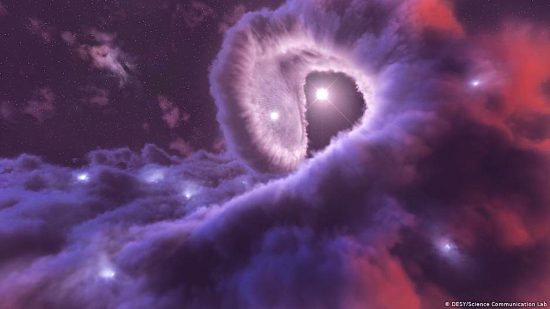
July 3, 2020
Eta Carinae is a binary system with a mass about 150-times that of the Sun. However, in contrast, it is shining with four-million-times the Sun’s brilliance. What causes this disparity?
The arc light from Eta Carinae is so bright that it generates X-rays powerful enough to be detected on Earth, 7500 light-years away. Eta Carinae also erupted with a flash of visible light, brighter than the Moon, in the 1800s. It then faded from visibility until 1941 when it slowly began to brighten to a naked-eye object. The variability can be attributed to the motions of two giant stars at the heart of the system.
Eta Carinae is located 7500 light years away in the constellation Carina. It is so energetic that it emits gamma rays with energies all the way up to 400 gigaelectronvolts (GeV), some 100 billion times more than the energy of visible light.
According to a recent press release, the radiation comes from the acceleration of charged particles. Calculations indicated that electrons must reach a velocity of 2000 kilometers per second for that level of synchrotron radiation. From the Electric Universe perspective, when electrons spiral in Eta Carina’s electromagnetic fields they emit synchrotron radiation. To the detectors observing stars, synchrotron radiation can be in the form of X-rays or gamma rays.
Conventional theories rely upon gravity and acceleration as the only way for high energy emissions to be produced in space. However, instead of “billiard ball physics” and “wind”, Eta Carinae confirms the Electric Star hypothesis.
In 1968, Dr. Charles Bruce proposed that planetary nebulae, like Eta Carinae, are electric discharges. Since it is part of a galactic circuit feeding power into the stars, nebulae like Eta Carinae exhibit a characteristic bipolar form along the current axis, with a toroid around the equator. As previously written, Eta Carinae’s output is largely absorbed by dust. This explains the high temperatures far from the star.
Instabilities in its plasma environment can be seen in the dark filaments twining through Eta Carinae. Those bursts of energy cause supernova-sized exploding double layers (the “bubbles” throughout the nebula). Double layers accelerate electrons and ions to relativistic velocities. Electrons spiral in the magnetic fields, emitting synchrotron radiation. Slower electrons emit radio waves. The highest energy particles reach escape velocity to form cosmic rays. All of these effects are supposed to be due to kinetic shock, even though the observed “wind” is ionized particles.
Stephen Smith
The Thunderbolts Picture of the Day is generously supported by the Mainwaring Archive Foundation.












